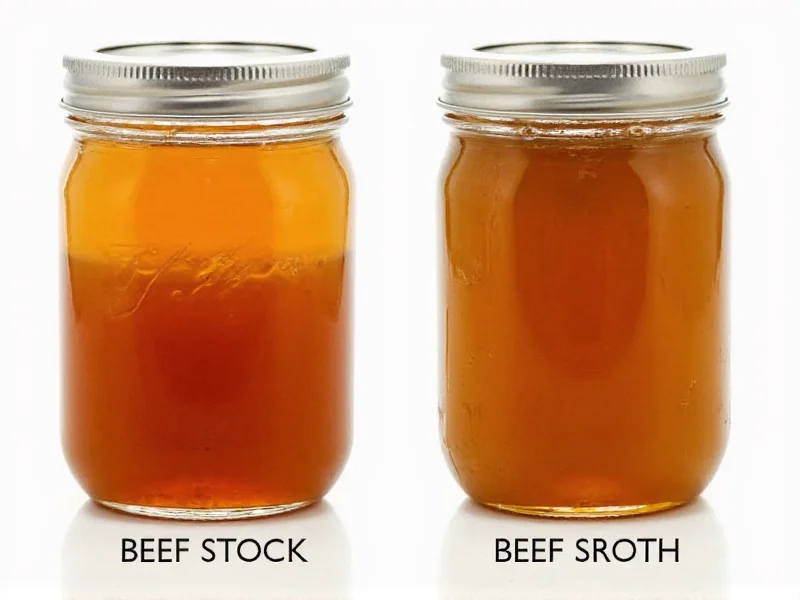Understanding the distinction between these two culinary staples can transform your cooking results. While many recipes use these terms interchangeably, professional chefs and serious home cooks recognize important differences that affect texture, flavor, and final dish quality.
Defining Beef Stock: The Foundation of Flavor
Beef stock serves as the culinary foundation in many professional kitchens. Created by simmering beef bones—often with some meat still attached—for an extended period (typically 6-12 hours), stock extracts collagen and marrow from the bones. This slow process produces a liquid rich in gelatin, which gives stock its characteristic thickness when cooled. The resulting liquid has a more neutral flavor profile, making it an ideal base that won't overpower other ingredients in complex dishes.
Professional chefs prefer homemade stock because commercial versions often lack the depth and body of properly prepared stock. When refrigerated, quality beef stock will solidify into a jelly-like consistency due to its high gelatin content—a clear indicator of proper preparation.
Understanding Beef Broth: Ready-to-Use Flavor
Beef broth differs significantly in both preparation and purpose. Made primarily from meat (with fewer bones), broth simmers for a shorter duration (1-3 hours), extracting immediate flavor rather than gelatin. Manufacturers typically season broth with salt and other flavorings, creating a product that's ready to consume on its own as soup or sip.
The shorter cooking time means broth contains less gelatin than stock, resulting in a thinner consistency. This makes broth more versatile for dishes where you want immediate flavor without altering texture. Most store-bought "broth" products are actually more similar to stock in composition but labeled as broth due to consumer familiarity with the term.
Key Differences Between Beef Stock and Beef Broth
| Characteristic | Beef Stock | Beef Broth |
|---|---|---|
| Primary Ingredients | Bones (with some meat) | Meat (with fewer bones) |
| Cooking Time | 6-12 hours | 1-3 hours |
| Gelatin Content | High (jellies when cold) | Low (remains liquid) |
| Flavor Profile | Neutral, subtle | Bold, seasoned |
| Salt Content | Unseasoned | Typically seasoned |
| Primary Use | Culinary base | Ready-to-consume |
When to Use Each in Your Cooking
The difference between beef stock vs beef broth matters most in specific applications. For sauces, gravies, and braises where texture and body are crucial, beef stock's gelatin content provides superior mouthfeel and natural thickening. The neutral flavor allows other ingredients to shine without competing seasoning.
Beef broth works better when you need immediate flavor impact—think soups, stews, or dishes where the liquid component should be noticeable. Its pre-seasoned nature saves time in preparation, though serious cooks often prefer to season their own stock to control sodium levels and flavor profiles.
Substitution Guidelines: Beef Broth for Stock and Vice Versa
Can you substitute beef broth for beef stock? Yes, but with important caveats. When substituting broth for stock in recipes requiring body (like demi-glace or reductions), you'll need to compensate for the lower gelatin content. Try reducing the broth by half to concentrate flavors and thicken the liquid.
Conversely, when using stock in place of broth, remember it lacks seasoning. Always taste and adjust salt and other seasonings at the end of cooking. For clear soups where appearance matters, broth's cleaner appearance may be preferable to stock's cloudier texture.
Homemade vs Store-Bought: Quality Considerations
Commercial products often blur the distinction between stock and broth. Many products labeled "beef broth" actually contain more bone material than traditional broth, while some "stock" products include significant seasoning. Reading ingredient labels carefully reveals the truth—true stock should list only bones, vegetables, and herbs without added salt.
For serious culinary applications, homemade versions provide superior control. A proper beef stock recipe involves roasting bones first, then simmering with mirepoix (carrots, celery, onions) and aromatics for at least 8 hours. Beef broth recipes focus on meat simmered with vegetables and seasonings for 2-3 hours.
Practical Tips for Best Results
When making beef stock at home, include some meaty bones like oxtail or shank for better flavor development. Skim impurities regularly during the first hour of simmering for a cleaner-tasting stock. For beef broth, use tougher cuts of meat that benefit from longer cooking, like chuck roast.
Proper storage extends usability—freeze stock in ice cube trays for easy portioning, or reduce it to a glaze ("glace de viande") for intense flavor concentration. Always cool stocks and broths rapidly before refrigerating to maintain quality and food safety.











 浙公网安备
33010002000092号
浙公网安备
33010002000092号 浙B2-20120091-4
浙B2-20120091-4